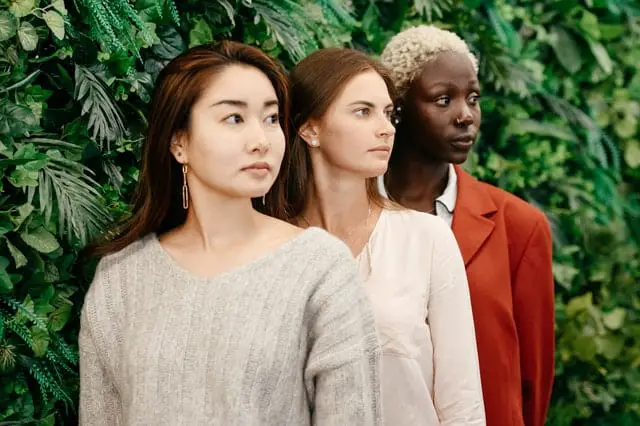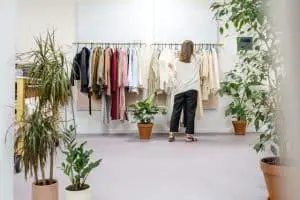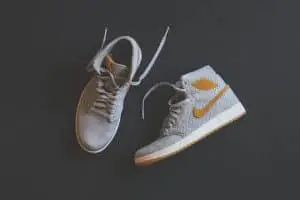Introduction
With everything going on in the world, inclusivity has been a widely discussed topic. Inclusivity is not a new concept, however, it has been gaining more attention over the recent years. Inclusivity in the fashion industry is not always present but has been changing along with the conversation. Usually, being inclusive is referring to the sizes, but it can also mean using models of all different sizes and who are racially diverse. This will help give customers a better idea of what would look good on their body type and with their skin tone.
A lot of brands do not carry plus-size options, or if they do, they completely change the style of clothing. Instead, brands should just be extending the size range on the same product, and maybe change a few small details so that it still fits well. This means not only creating larger sizes but also having smaller sizes too. Some stores only carry sizes small-large, which is not going to fit a varied group of people that cannot fit into the small or large sizes.
People want to feel included and that they are welcome to shop at the store. Finally, many companies are beginning to extend sizes and include models of all sizes on their websites and social media.
Being an inclusive brand is important, and here are five ways to be more inclusive:
- Diverse models
- More sizes
- Clothes for all body types
- Representation
- Marketing technique
1. Diverse Models
A lot of the time in the fashion industry, the clothing is put on tall and slim models, and many brands do not include a lot of different ethnicities and races. However, only a small population of people fit the same standards as the models, so a lot of people do not get to see how the clothing would look on their body type.
That is something that needs to change. Everyone has different measurements, so it might be hard to match someone’s body type perfectly, but it would be very helpful for someone to be able to see how the length of pants fit on different heights, or how a shirt looks on someone who is a small or a large, etc.
The customer would be more willing to buy something if they know what it will look like on them without even having to try it on. It will prevent them from returning it and might make them more interested in the brand since they are including different-sized models.
In addition to including the different sizes, it is important to include diverse models of different races and ethnicities. We will get into representation later on, which is an important part of diversity, but it is also helpful to see how a certain color might look. No matter what, having diverse models is only going to help a brand.
Brands like Aerie and American Eagle, for example, do a great job of showing different-sized models for their jeans and their bathing suits.
2. More Sizes
With the use of diverse models, the array of sizing should match. Once again, this not only includes larger sizes but smaller sizes as well. Having sizes XXS to XXL is a good place to start, but if possible, the sizes should be extended even more to include 2X to 5X. Having these sizes will gain more traffic for the people that cannot find their sizes, and it will once again make them more willing and comfortable to buy from your brand.
It can be upsetting when people find a cute item and then realize that they don’t make their size, or that they have to special order it. All of the sizes should be readily available unless there is no demand for a certain size. Then there may need to be an experimental phase to figure out what sizes sell.
3. Clothes for All Body Types
Now that we have gotten through with diverse models and having extended sizes, it is also a good idea to have different styles that fit all body types. Some people may not feel comfortable wearing a certain style, so having a wide range of options is good for everyone. If a lot of the shirts are tank tops or crop tops, that might not be inclusive for everyone. Perhaps you could use the same colors, materials, and patterns to address this issue.
4. Representation
Representation might be one of, if not the most important reason to be more inclusive. Representation is also an issue in Hollywood and in the cosmetics industry. People do not feel represented because they do not see anyone that looks like them. In Hollywood, there has been a lot of controversies recently with the number of white actors and directors winning awards. Also, there’s been a concern with straight actors playing LGBTQ+ roles and not using people with disabilities to play like roles. People in those communities do not feel represented.
This same thing can happen with clothing. Your customers might not see a model that looks like them, or they may not find their size anywhere. However, by including diverse models and having more sizes, people will feel more represented. Everyone deserves to feel represented in the fashion industry.
A lot of people feel that diversity is the first step, and inclusivity is the second step. Diversity can be having models of different races, while inclusivity is incorporating more diversity behind the scenes, in your workforce, and including more sizes in stores and on the websites.
5. Marketing Technique
It should go without saying that being inclusive should not need an incentive to go along with it. It should automatically be incorporated for the betterment of society and representation. However, some companies might be worried about the business side with having to raise production and manufacturing costs. This should not be a big concern considering the number of customers should increase along with the new sizes, and being inclusive is going to help improve brand image.
Every company wants to have a good image, and that is a marketing tool within itself. By having diverse models and clothing with more sizes, people will think better of the company. Many companies were under scrutiny because of their size range or brand image. For example, Abercrombie & Fitch was controversial because their CEO at the time said their clothes were for skinny, popular people. Many people were upset about that and stopped shopping there. That is not the way you want your brand to be viewed. Also, the company Brandy Melville gets a lot of criticism for having a lot of stuff that is One Size Fits All. Both of these companies are doing fine and they still get a lot of business from the people that fit in the clothes. But it doesn’t stop them from having people dislike their brand and losing the sales of a more diverse group of customers.
Conclusion
Inclusion is finally starting to get the attention it deserves, but there is still a long way to go in the fashion industry. Every brand should aim to be more inclusive, even if they start with a small step. Fashion is all about expressing yourself, and there is currently a group of people who may not be able to express themselves to their fullest potential. They might not be able to find clothes that fit, or that look good on their body type and skin tone.
By having more representation, people will feel more confident in themselves and comfortable shopping at your store. Everyone should be able to find clothes that make them feel confident, and that fit them well.







